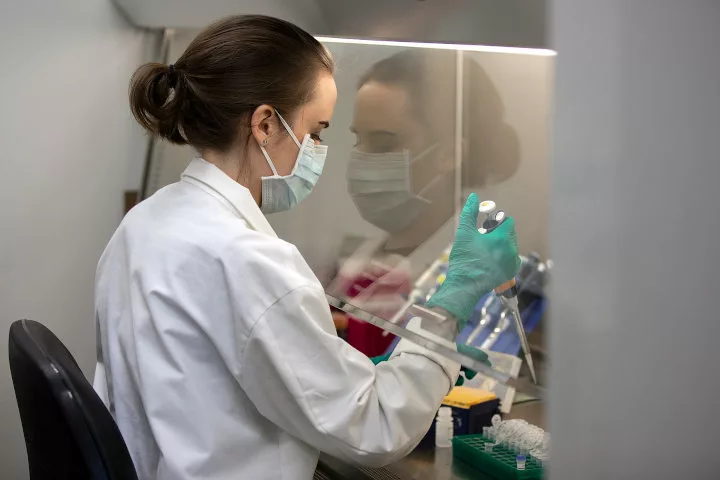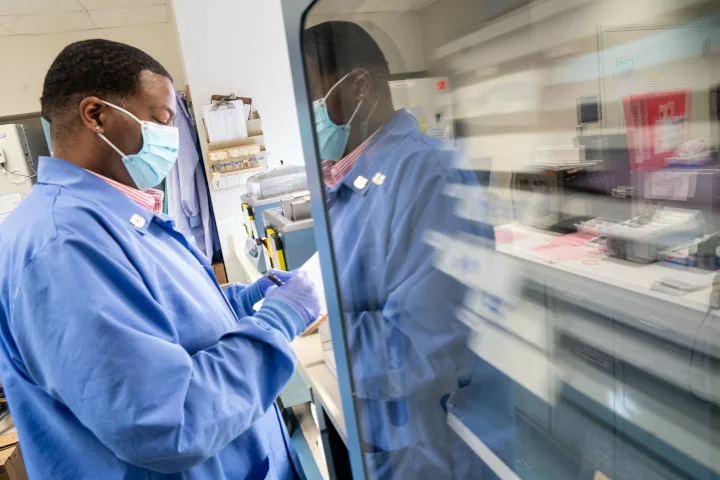Paul Wertsch Exemplifies Community-minded Physician, Entrepreneur and Advocate
As a young man living in Madison in 1960s, Wertsch says he couldn’t help but be influenced by the political unrest and social activism around him.
Cameron Currie, PhD, regularly poses questions to students in “Diversity, Ecology and Evolution of Microbes,” the yearly class he teaches at University of Wisconsin–Madison. When the topic turns to pandemics, Currie asks the students if they think one is likely to happen. Until recently, most of them dismissed the possibility.
“My job is to convince the students they were wrong,” he notes wryly.
In this case, the correct answer to the pandemic question presented itself in late 2019 and early 2020. When Currie heard that the reproduction number, or R0 value, of the SARS-CoV-2 virus in Wuhan, China, was around 2.5, he knew things would get worse.
“When I heard that, I thought ‘This is going to be really bad,’” recalls Currie, a professor in the UW–Madison College of Agricultural and Life Sciences who often collaborates with faculty members of the University of Wisconsin School of Medicine and Public Health and other UW–Madison units.
Now, he and his team are among 23 individuals and groups receiving grants from the school’s Wisconsin Partnership Program (WPP) to address the COVID-19 pandemic caused by SARS-CoV-2. The Wisconsin Partnership Program awarded 11 community and 12 research grants totaling $2.9 million. The funded work ranges from basic biomedical research to community-led initiatives addressing the immediate health needs of the state’s most vulnerable communities.
As the pandemic began to unfold in March, WPP’s leadership team — including Robert N. Golden, MD, dean, School of Medicine and Public Health; Richard Moss, PhD, chair, Partnership Education and Research Committee (PERC); Amy Kind, MD ’01, PhD ’11 (PG ’05, ’07), chair, Oversight and Advisory Committee (OAC); and Eileen Smith, director — quickly assembled to discuss a rapid response to address the virus.
The PERC and OAC developed the COVID-19 Response Grant Program with funding opportunities to support researchers both within the School of Medicine and Public Health and across campus, as well as community-led initiatives.
“We have virology researchers on campus who are international leaders in the field,” observes Moss, the school’s senior associate dean for basic research, biotechnology and graduate studies. “We thought it important to open a fund to build upon existing technologies developed here and apply these to COVID-19.”
Working at an unprecedented pace, the Wisconsin Partnership Program went from seeking proposals to awarding grants within two weeks. The projects, funded after prompt but vigorous review, span the spectrum of critical needs arising from the pandemic. Here is a snapshot of some funded projects.
Currie leads a team studying the community of microorganisms in the upper airway. Among others on campus, the team includes three professors from the UW Department of Medicine: James Gern, MD; Nasia Safdar, MD, PhD (PG ’00); and David Andes, MD (PG ’95, ’98), who also is chief of the department’s Division of Infectious Disease.

This group is searching for nasal-tract microbes that show anti-viral activity and testing their safety in mice. If successful, the effort may help shorten the lengthy and costly process of developing anti-viral therapeutics.
The study’s second goal is to analyze nasal swabs from the UW–Madison BioBank of COVID-19 specimens to look for patterns that might predict disease severity. Currie’s team will generate data that represents a range of clinical outcomes, and the investigators will look for correlations between features of the microbiome and the severity of illness. If clear patterns emerge, they can investigate the mechanisms underlying various courses the disease takes.
Because enhanced antibody testing is crucial to successful management of the COVID-19 pandemic, a project headed by Andes also has a dual focus. His lab is identifying samples from patients infected with the SARS-CoV-2 virus and providing them to a biotechnology company, which is using highly sensitive assays with the goal of improving detection of viral particles.
The second goal is to develop treatments from the monoclonal antibodies the biotechnology company produces. Once shown safe and effective in mice, the therapy could move into clinical trials. Then, if the antibodies can be manufactured on a large scale, they could potentially replace convalescent plasma, which is being studied.
Andes’s first reaction, like Currie’s, was that the pandemic would be catastrophic. But he sounds a note of optimism.
“I’m really amazed at how people have stepped up, especially on campus,” he says. “Our faculty and staff are coming up with all sorts of innovations to make a difference.”
In spring 2020, dermatologists worldwide noticed a marked increase in the number of patients presenting with reddish-purple blotches on their toes, and they suspected a link to COVID-19. A theme among the reports was that patients were young, with mild or no viral symptoms, and improved spontaneously. The lesions looked like chilblains, a rare condition that occurs due to exposure to extreme cold, but they were appearing at an uncommon time for chilblains.
Among those seeing an increasing number of such patients was Lisa Arkin, MD, an assistant professor in the UW Departments of Dermatology and Pediatrics. Recognizing that chilblains in young children typically signify a genetic disorder that also produces elevated levels of Type 1 interferon, she hypothesized that “COVID toes” might signify a similar response to the novel coronavirus. Type 1 interferons are pivotal in the early response to viral infections, and gene mutations that diminish these responses lead to extreme susceptibility to respiratory viruses. Patients with severe COVID-19 have attenuated and delayed Type 1 interferon production, fueling failed viral control and subsequent inflammation. All of this suggested a link between the skin findings and increased levels of interferon early in the disease, which could protect patients through early viral eradication, preventing worsening symptoms.
With support from a WPP grant, Arkin and co-investigator Anne Marie Singh, MD (PG ’09), an associate professor in the UW Department of Pediatrics, are collaborating to test that theory. Forty patients of an expected 160 from Wisconsin have been enrolled as of early September 2020. Tissue samples are being analyzed to identify patterns of gene expression in the immune system along with gene testing to look for changes in interferon-related genes. It’s hoped that mapping of the immune signature in these patients will drive the development of preventive therapies.
The pandemic in the United States has underlined major social, economic and health disparities between the mainstream culture and marginalized groups. For Hmong and other Southeast Asian refugee communities, difficulties are compounded by a lack of public health and medical information available in their languages.
The Hmong Institute, a non-profit organization based in Madison, is working with six Wisconsin communities that have significant former and current refugee populations from Southeast Asia.
A WPP grant supports three major initiatives:
Mai Zong Vue, board president of the Hmong Institute, says these communities must rely on organizations they trust to understand how their members feel.
Launched in August 2020, the bilingual resource hotline has quickly proven valuable. As word of the service spread, it started receiving dozens of calls. Access to mental health resources is especially vital for these communities because factors related to the pandemic, including social isolation, are re-traumatizing some individuals who have post-traumatic stress disorder from their upheaval during wartime in their homelands and refugee camps.

Carey Gleason, PhD, was meeting with Black members of the Team for Brain Health as news of the pandemic started to emerge. Team members urged her to think holistically and find a way to encompass COVID-19 education in her outreach work related to Alzheimer’s disease. An associate professor in the UW Department of Medicine’s Division of Geriatrics and Gerontology, Gleason teamed with colleagues to come up with the idea of using social influencers established in their respective communities to deliver accurate messages about COVID-19.
Gleason, Maria Mora Pinzon, MD (PG ’17), physician-scientist, Wisconsin Alzheimer’s Institute, and Melissa Metoxen, community and academic support coordinator, Native American Center for Health Professions, are co-principal investigators on a WPP grant. They developed what Gleason calls “a brilliantly simple model.” They identified key people from the Black, Latinx and American Indian communities to help pinpoint topics; develop targeted, science-based communications; and use social media to convey messages.
The team influencers are Sacheen Lawrence for the Oneida Nation, representatives of the Latino Health Council of Dane County and Venus Washington, a personal trainer and health coach. Washington had worked with Gleason for three years on a “Get Moving” class for people ages 60 and above. As she hosts exercise classes online and posts motivational messages on social media, Washington emphasizes the importance of having health messaging come from a member of the community.
“Within our own community, there’s a different type of culture — sometimes fear gets in the way,” she says. “You’re not sure if information is for your own good.”
Washington shares that having a trusted member of a community vouch for the message adds to its credibility.
While acknowledging that the injustices the pandemic has highlighted won’t be eradicated in a grant cycle, Kind says the WPP has a unique role to play.
“Reducing health disparities and advancing health equity is woven into the very fabric of the Wisconsin Partnership Program,” she points out. “The COVID-19 community grants help community-led organizations meet the health needs of the most vulnerable populations during the pandemic and beyond.”